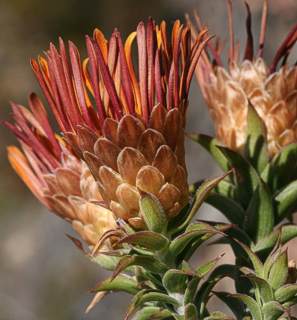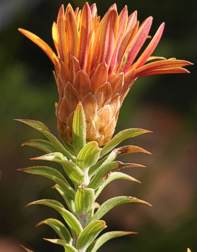Relhania speciosa
Relhania speciosa (DC.) Harv.
Family: Asteraceae
Common names: perdekaroo (Afr.)
Introduction
This member of the Relhania group of daisies, which are largely endemic to southern Africa, is striking for its tall stems covered in sharp, rigid leaves and its large flower heads with dark orange-yellow flowers.

Description
Description
Relhania speciosa is a tall, sparsely-branched shrub up to 2 m high with long slender stems covered in spreading or recurved, rigid grey-green leaves. The leaves are hard and spine-tipped, making the plant well suited for survival in arid parts of the Cape Floristic Region. The flower heads are solitary at the ends of the branches; they are surrounded by layers of pale brown involucral bracts and florets which are dark yellow to orange. The plants flower in spring and summmer.


Conservation Status
Status
Not threatened (not mentioned on the interim Red Data List).
Distribution and habitat
Distribution description
Relhania speciosa occurs on rocky and stony mountain slopes in the arid karoo of the Cape Floristic Region, in the Riviersonderend Mountains, Matjiesfontein, Witteberg, Swartberg, further east around Anysberg, and Baviaanskloof towards Humansdorp and Port Elizabeth.
Derivation of name and historical aspects
History
The genus Relhania is named after the Reverend Richard Relhan who was a botanist, a fellow of King's College, Cambridge, a rector in Lincolnshire, and author of Flora Cantabrigiensis. He died in 1823. The name Relhania was applied in 1786 by the French botanist L'Héritier after working through Francis Masson's collections from the Cape of Good Hope. The specific epithet speciosa is derived from the Latin word speciosus and means showy, splendid.
There are currently 14 species recognised in Relhania but the generic boundaries may not be upheld and phylogenetic analysis is required to determine its relationships to other genera in the Relhania group, especially Oedera, Rosenia, Nestlera and Leysera.
Uses
Use
There is little information on the uses and cultural knowledge of Relhania. Relhania genistifolia is considered an agricultural weed. Watt & Breyer-Brandwyk (1962) report that the leaves of several Relhania species have a pungent taste in spring, and that R. cuneata twigs and leaves yield a pale yellow, volatile oil. Tsichritzis & Jakupovic (1990) found several different types of terpenes in Relhania species. Terpenes are important biological molecules (e.g. vitamin A) and are the major components of resins; turpentine is produced from resin. Terpenes and their modification products, terpenoids, are the primary constituents of the essential oils found in many types of plants. Essential oils are used widely as flavour additives for food, fragrances in perfumery, and in traditional and alternative medicines. Further research into the terpenes of Relhania is required.

Growing Relhania speciosa
Grow
Several species in the genus, including Relhania speciosa, make showy and attractive rock garden plants. They grow in sunny, dry rock crevices and require protection against wet winters. R. speciosa prefers nutrient-poor, well-drained soil and full sun. It is propagated from seed sown in spring.
References
- Bremer, K. 1976. The genus Relhania (Compositae). Opera Botanica 40: 1-86. Stockholm.
- Tsichritzis, F. & Jakupovic, J. 1990. Diterpenes and other constituents from Relhania species. Phytochemistry 29: 3173-3187.
- Watt, J.M. & Breyer-Brandwyk, M.G. 1962. The medicinal and poisonous plants of southern and eastern Africa. Livingstone, Edinburgh.
- Wells, M.J., Balsinhas, V.M., Joffe, H., Engelbrecht, V.M., Harding, G. & Stirton, C.H. 1986. A catalogue of problem plants in southern Africa, incorporating the National Weed List of South Africa. Memoirs of the Botanical Survey of South Africa No. 53. Botanical Research Institute, Pretoria.
- website: Rock Garden Plants Database http://www.kadel.cz/flora/kvSearch.html (English version translated from the original database written in the Czech language).
- website: Terpenes. Wikipedia http://en.wikipedia.org/wiki/Terpene
Credits
Nicola Bergh
Compton Herbarium, Kirstenbosch NBG
March 2009
Plant Attributes:
Plant Type: Shrub
SA Distribution: Eastern Cape, Western Cape
Soil type: Loam
Flowering season: Spring
PH: Neutral
Flower colour: Yellow, Orange
Aspect: Full Sun
Gardening skill: Average
Special Features:
Horticultural zones









Rate this article
Article well written and informative
Rate this plant
Is this an interesting plant?
Login to add your Comment
Back to topNot registered yet? Click here to register.